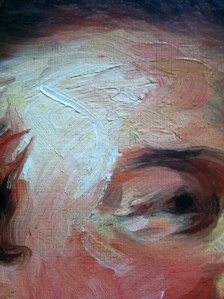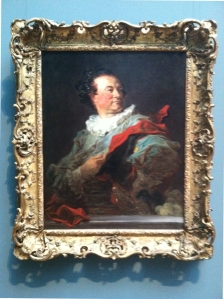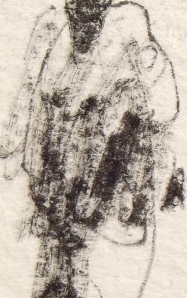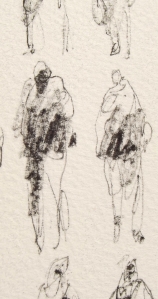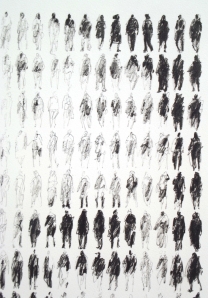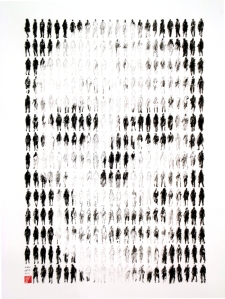Filed under: Uncategorized | Tags: art, art process, contemporary art, drawing, inkonpaper, sketchbook
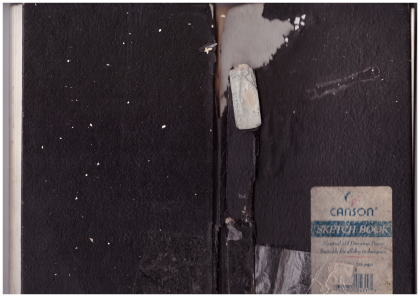 My brother Scott visited from Long Beach, California, and he brought me this water-damaged sketchbook from more than 20 years ago. I thought my old drawings might be kind of embarrassing. Scott’s an artist, he’s smart, and he thinks a lot. He suggested that it would be less important to me how the drawings looked, and more important remembering where I was when I drew the sketches. He’s often full of wisdom like that.
My brother Scott visited from Long Beach, California, and he brought me this water-damaged sketchbook from more than 20 years ago. I thought my old drawings might be kind of embarrassing. Scott’s an artist, he’s smart, and he thinks a lot. He suggested that it would be less important to me how the drawings looked, and more important remembering where I was when I drew the sketches. He’s often full of wisdom like that.
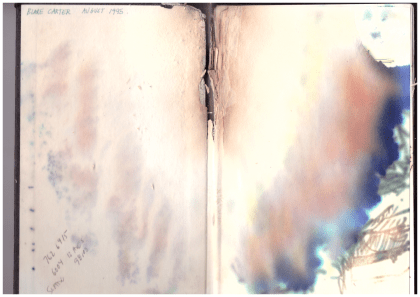
Scott was right. The drawings were better than I’d thought they would be, but the trip down memory lane was even better. I finished college in 1994, and this sketchbook is from the year after. I’d just moved into my first apartment ever in Georgetown, south Seattle, and had a painting studio down the street that I shared with Scott. The place I lived in wasn’t so nice. I came home once to find a neighbor passed out on the stairs with a 2×4 in one hand and a case of Schmidt Ice in the other. A visiting girlfriend discovered that someone pooped in the communal shower. There was screaming and ambulances, and there was a mouse that lived in my stove. The opening page of the sketchbook reads “August 1995,” and towards the end of the book there’s a drawing dated November 1996.
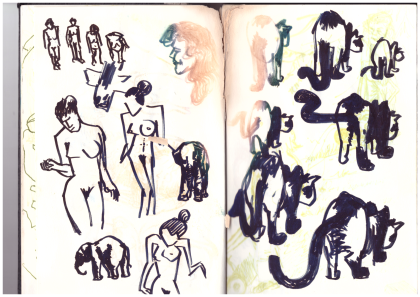
The drawings aren’t bad like I’d feared. This one on the right, like a lot of them, was based on art I saw in a magazine or book. I think the cats are from a Japanese ink painting I saw somewhere. The figures on the left remind me that I was reading Norman Mailer’s “Portrait of Picasso as a Young Man,” published that year.
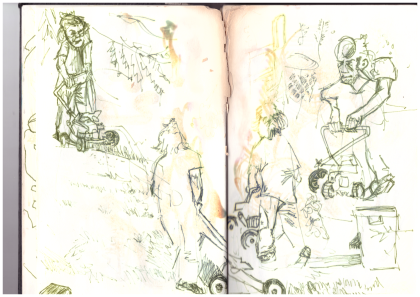
I drew these in the yard of my parent’s house in Gig Harbor, Washington. That’s Scott mowing the lawn. I was interested in blind line-drawings at the time, kind of makes everything look a bit cubist.

I was totally fascinated with Francis Bacon, still am. He’d just died a few years before. Interesting how differently the inks on the left and right pages held up. These days I try to only use art materials that promise to be “archival quality.”
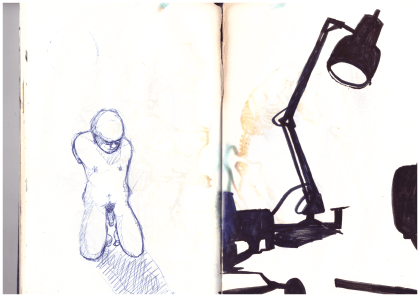
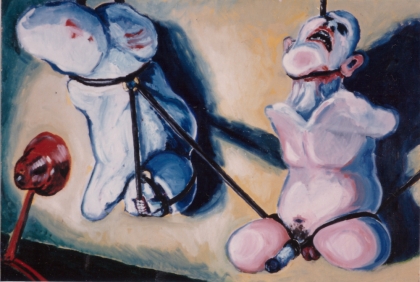
The studies above became part of my first oil painting. I’d painted with oils before, but just student work and none of it was very good. This one turned out well, I think. Friends teased me about the subject matter. I wanted something that would catch attention.
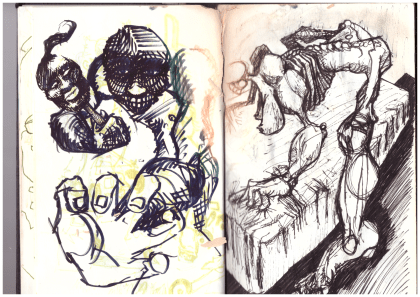
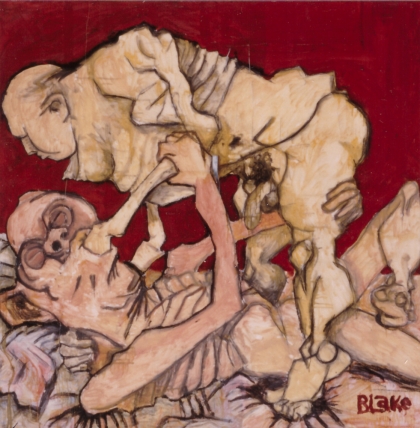
The drawing to the right, above, also became part of a painting. I drew people as structures, like buildings or machines. Line quality and shapes meant more than the figures I was piecing together. You can tell I was looking at Picasso. The painting is acrylic on a failed oil painting. It’s now rolled up under my bed, falling to pieces.
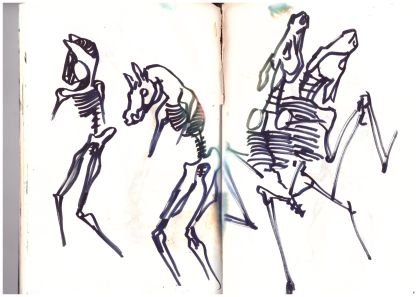
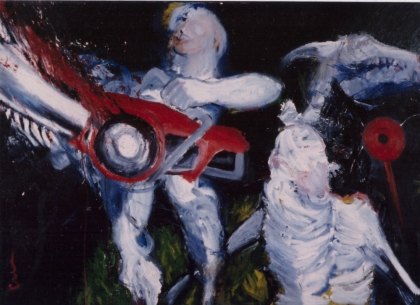
Always fascinated by skeletons. Not sure where I was going with the horse sex thing, but there are a few in this sketchbook. The horse skull later made an appearance in my favorite oil painting from this time. I still have my paintings from this period, but they’re in bad disrepair because I painted on top of old paintings. Someone told me it didn’t matter, I just had to keep painting. It sounded good because I didn’t have money for new canvas every time I didn’t like a painting, but it was a mistake.
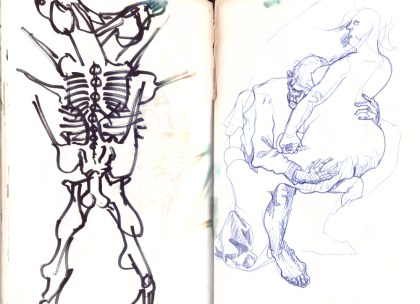
More horse sex, and a copy of Otto Dix from a book.

I think I thought there was something sexy about horse legs. For the record, I’ve never purposely peed on a shoe.

Saw this chapel on a family vacation, maybe in Utah.

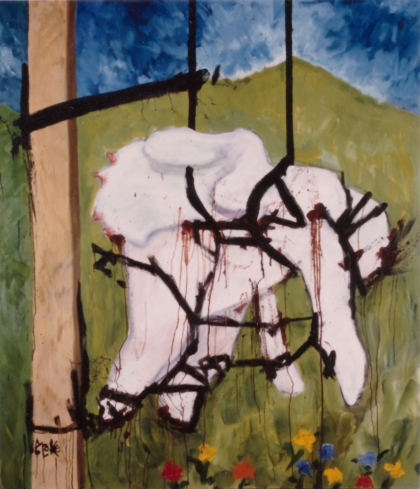
I got interested in things hanging by leather straps. Not really personally interested, but I thought it looked good. The above sketch turned into my largest painting to date. The painting contains a literary joke: “The grass is always greener” on the left side of the post.
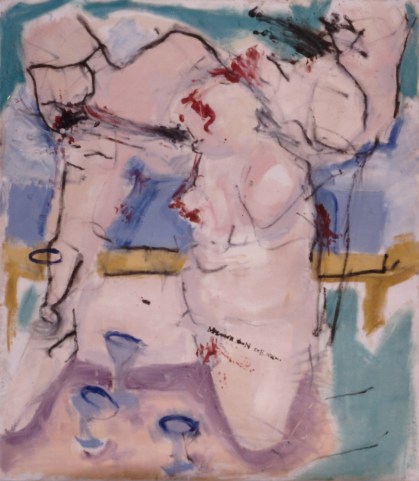
I got pretty excited about jokes in paintings at the time. Friends had been teasing me about how I always had penises in my paintings, so in this one I didn’t paint the penis, but instead there’s text that reads “The … mightier than the sword,” leaving out the words “pen is” right where the missing penis would be. Brilliant! No one ever thinks it’s as funny as I do.

Here’s one of my best memories to date, toward the end of the sketchbook. Me and my girlfriend at the time went camping together on the Baja Peninsula. We’d realized we weren’t perfect for each other, but decided to have a last hoo-rah trip anyway. I saw her once again after that, in Southeast Asia. It’s been almost twenty years since we said goodbye in Hoi An, Vietnam.
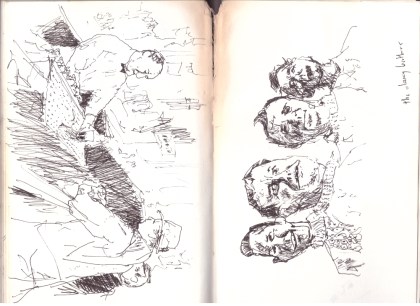
I’m not sure whether this one on the left is based on a picture or something I just did freehand. Either way, I definitely had more patience than I do now. On the right the Clancy Brothers, from a photograph.

It’s weird looking at these drawings from so long ago. They’re mine, but for the most part, I don’t remember drawing them. It reminds me that I can be a different person in different contexts. I recently heard an NPR podcast about the fallacy that people are born and live with a certain personality. You’d assume that it was a thread you could follow through someone’s life, but really, people adapt to the situations they experience.

This old sketchbook is from 1995, when I was 23 years old. I turned 45 this October. My “art career” hasn’t really taken off (yet). I kind of put art in the back of my mind in my late 20s, and though I never stopped sketching and thinking about art, there was a gap of ten or so years when I didn’t push myself to make finished pieces I was proud of. I thought I’d never be able to make money from art, so I concentrated on other things. I came back to it about ten years ago. While working for a newspaper in Taiwan and interviewing artists for articles about their shows, I realized that I liked making art better than anything I’d done to pay bills or have health insurance or all that. So now I have a day job delivering beer that gives me three-day weekends, but really I’m an artist, and I’m happier with my artwork than I’ve ever been.
Filed under: GICKERS, Uncategorized | Tags: architecture, art books, artist biographies, book reviews, frank lloyd wright, literature
As I’ve noted previously in this blog, I love art biographies. While an undergraduate art student, I memorized a few dates, locations, and names of buildings designed by Frank Lloyd Wright, but never knew much about him, so I recently read Meryle Secrest’s Frank Lloyd Wright: A Biography.
Based on Secrest’s account, I now picture FLW as an intolerant, delusional a**hole who thought his artistic talents an excuse for abhorrent treatment of friends, family, and business partners. Strangely though, the a**hole became slightly more loveable as I finished the book. I admired his vision and stalwartness (is that a word?), but find it hard to imagine a person so oblivious to others.
I often fold down the corners of book pages when I read something that I may want to reference again. Here’s what I bookmarked in Secrest’s FLW biography (page numbers are based on the 1992 University of Chicago Press paperback edition):

Page 114: Writing about the “American house” around the turn of the century (19th to 20th), Secrest quotes FLW as saying, “It was vulgar, wickedly extravagant, a national waste, ‘a moral, social, aesthetic excrement.’” Later in the paragraph Secrest writes that the first argument between FLW and his first wife Kitty came “as she objected to his plans to inscribe ‘mottoes’ around their house, and he just as heatedly insisted. What he wanted were daily exhortations, reminders of right matters, right morals, right reflections upon the nature of things. Despite her, he managed to have ‘Truth Is Life!’ carved over the fireplace of their first living room.”
I’m not sure if I folded this page because of the wonderful phrase “moral, social, aesthetic excrement,” or because FLW would say such things and then insist on emblazoning his home with cheesy inspirational sayings.
Page 186: “For Americans oriented toward the Arts and Crafts Movement, Japan offered ‘the example of an indigenous culture that embodied the organic quality they found in the middle ages,’ as Richard Guy Wilson wrote.”
Yes Secrest is quoting Wilson, but I’m collecting sentences by writers who may or may not realize their verbage makes me snicker, and the “oriented toward … Japan” is a good one.
Page 429: “[FLW] would argue a point vehemently until she [his third wife], to end the fight, would drop her opposition. Sometime later, having changed his mind, he would chastise her for having allowed him to make such a fool of himself.”
I think I folded down this page because this seemed like typical a**hole behavior that I can regretfully see myself having been guilty of, but that I hope I’ve removed from my repertoire. Secrest writes like a psychoanalyst, and this is a good example of what she does well.
That’s it! There were a few other folded-down pages that left me wondering why they were folded down, or couldn’t sum them up in this blog post. I finished the book a couple of months ago and was happy I did. Secrest writes pretty well, but not so well that you’d read the book if you weren’t interested in the subject. Sorry Secrest, but I’m comparing you to my favorites like Borges, who could write about the hair growing out of his nose and I’d be thrilled.
Anyone else read Secrest’s FLW book?
Filed under: SCRAPS, Uncategorized | Tags: art technique, chuck close, contemporary art, de kooning, fragonard, franz kline, goya, jim morrison, leibovitz, modern art, rembrandt, sakura
I’ve been thinking of this painting by Jean-Honore Fragonard since I saw it a couple weeks ago at the Getty in Los Angeles (detail above). It’s certainly not the kind of thing I’d expect from the painter of The Swing and other cloying confections. The impasto brushwork looks more like something you’d expect from Goya or Rembrandt. And wouldn’t you know it, Frago admired and sometimes copied Rembrandt’s paintings, according to John Canaday in The Lives of the Painters. (By the way, the excellent-condition, four-volume, used hardcover Lives is by far the best US$4 I ever spent on Amazon. Think I may have overpaid — there’s a set on Amazon now for $3.64.)
Stepping back a bit the head emerges. I wonder if a less confident artist would have tried to blend in the four grey marks on the duke’s jowls.
Here’s the full picture, above. Don’t know if I would have been terribly interested to take a closer look if I’d just seen this image in a book. There’s an affected gallantry that I imagine the subject loved, but it strikes me as a little over the top. Glad I did though. The placard next to this painting notes that Frago spent “as little as an hour to complete each of the canvases” of the series that includes this work, which helps explain the “bravura brushwork of rapid, fluid strokes.”
I’m particularly interested in this Fragonard painting right now because I’ve been working on a similar effect in my Pedestrian Series. I discussed the difficulty of photographing my work and the importance of viewing my work in person in an earlier post. Below is a detail from my last work of 2012:
Recently I decided to try something that I’ve been knocking around for a while. I’ve been drawing figures with Sakura Pigma pens and Faber-Castell PITT Artist pens for a few years and feel I have a bit of control with them, despite the fact my process is reliant on a lot of “happy accidents” that occur while I’m scribbling. In the detail above you can see the variety of marks I use.
From the little distance of the image above (detail appr 2×3 inches), it’s obvious the marks in my piece describe individual figures. There are parts with heavier marks, and parts with lighter marks.
Now you see what I’m getting at. By altering the weight of the marks in each figure, I can use the smaller figures to create a larger image.
There’s the full piece, above. Nothing revolutionary. When I was in high school, the art teacher gridded out a Leibovitz picture of Jim Morrison and had her students each draw a small piece (maybe a foot square), then arranged them all and hung them in the lunchroom. Chuck Close also comes to mind, as well as every super-realist who talks about concentrating on the individual grids in an image and treating them as small, abstract paintings that add up to completed pieces resembling photographs.
It’s a simple idea, but it’s very important when looking at art, and paintings in particular. Any figurative or landscape piece can be broken up into an infinite number of smaller, abstract images. I’m currently reading a book about Alice Neel (Alice Neel: The Art of Not Sitting Pretty by Phoebe Hoban), who worked in New York in the middle of the last century, a time when critics and artists vigorously proclaimed allegiance to abstract versus figurative art.
They all seem a bit silly now. If I fail to see the figure of a woman in a painting from de Kooning’s Woman Series, is it abstract? What if I think Franz Kline’s work looks derivative of Chinese characters — does that make it more based in visual reality?
I’ve gone back and forth on the Chinese name chops for my scooter drawings, and now they’re back. I’d worried that it might seem a little hokey or make the allusion to Chinese calligraphy too obvious, but in the end I decided the bit of red amid all that black and white looks so good that it was worth it. Unfortunately I lost my chops in the move from Taiwan, but a friend of mine sent a couple new ones along and here they are. (Thank you Mr. Wheeler.)
When I compared the new image with the old, I realized my old chops printed my Chinese nickname backwards — “Bu-a” (布阿) instead of “A-bu” (阿布). It wasn’t really backwards as vertical Chinese text usually reads right to left, but with just the two characters you can’t tell whether you’re reading two single-character columns vertically or one two-character row horizontally. I like it better the new way. No doubt this will horrify the first Chinese person who notices, and I’ll be informed that I’ve ruined all the scooter drawings before/since I started using the new chops.

